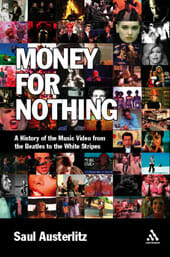
Music videos finally get their proper due as a legitimate art form for rigorous analysis.
There’s little doubt that music videos have played a profound role in shaping our perception of music, fashion and the cascading of water over lithe, backlit female bodies. But aside from a handful of books (including Andrew Goodwin’s superlative Dancing In The Distraction Factory), music videos haven’t been given their proper due as a subject for rigorous analysis. It makes little sense to shrug off videos as the banal backdrop of Reagan youth, the crap kids had to endure until “Smells Like Teen Spirit” saved the form from itself. Videos have seeped into every crevice of our visual life like toxic waste.
Saul Austerlitz, a freelancer who’s written for both Paste and Spin, has gamely plunged headlong into the abyss. Unfortunately, he’s come up a bit short. Austerlitz clearly doesn’t intend to condemn what he sees as a legitimate art form, nor is it his intention to gloss over the form’s deficiencies. Having it both ways, however, is problematic, as it gives the book an equivocating tone.
But Austerlitz is nothing if not thorough. He opens the book with an introduction that does a nice job of explaining just what this mutant media object connotes to the masses. Calling the music video an “underappreciated, critically unnoticed subgenre of filmmaking,” Austerlitz tells us that videos can “shed enormous light on pop music, mythmaking, and the enduring, limitless possibility of the music video as art form.” After a quick twirl though the history of music on film and video, Austerlitz gets to the heart of the matter.
He’s more interested in critical analysis than anecdotal history, and that’s fine. But all of that remedial, film-school imagery doesn’t really lend itself to textural deconstruction. In the end, it’s just silly visual gobbledygook. As Austerlitz systematically runs through what he thinks are the key videos of the MTV era, over-heated pontification takes over. In writing about Guns N’ Roses’ trilogy of videos that ushered in the era of massive-budget bombast, Austerlitz writes that “‘Don’t Cry,’ ‘November Rain,’ and ‘Estranged’ are deeply adult in their evocation of wounded spirits, that their summoning of the bittersweet and tragic is a far cry from the fantasy wish-fulfillment of the average music video.”
Really? I just thought they were ridiculous at the time, but perhaps I should take another look.
For anyone who came of age when MTV did, Austerlitz’s visual descriptions will be self-evident. Money For Nothing would be a stronger book if Austerlitz had set aside the frame-by-frame exegesis and given us a closer look at how music videos have changed the entire armature of culture—the banality of pop-culture evil, as it were.
The significant players of the music-video world are arguably not the celebrated directors who’ve graduated to film, like Spike Jonze and his ilk. Rather, it’s executives like MTV co-founder Bob Pittman, who cynically appropriated the big-tent market-testing techniques and demographic pie charts of radio and applied them to the most important music outlet of the past 30 years. In the final analysis, MTV was the same old commercial con job that has played such a huge role in the dissemination of rock music since the ’50s. Money for Nothing, indeed.